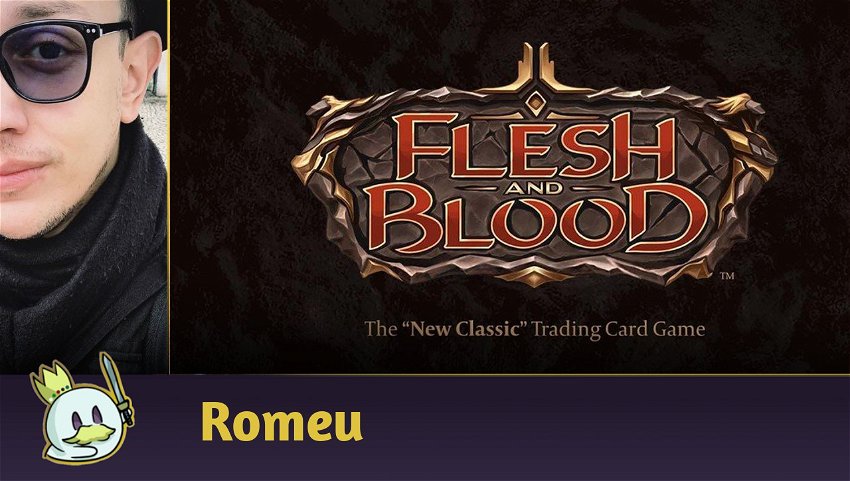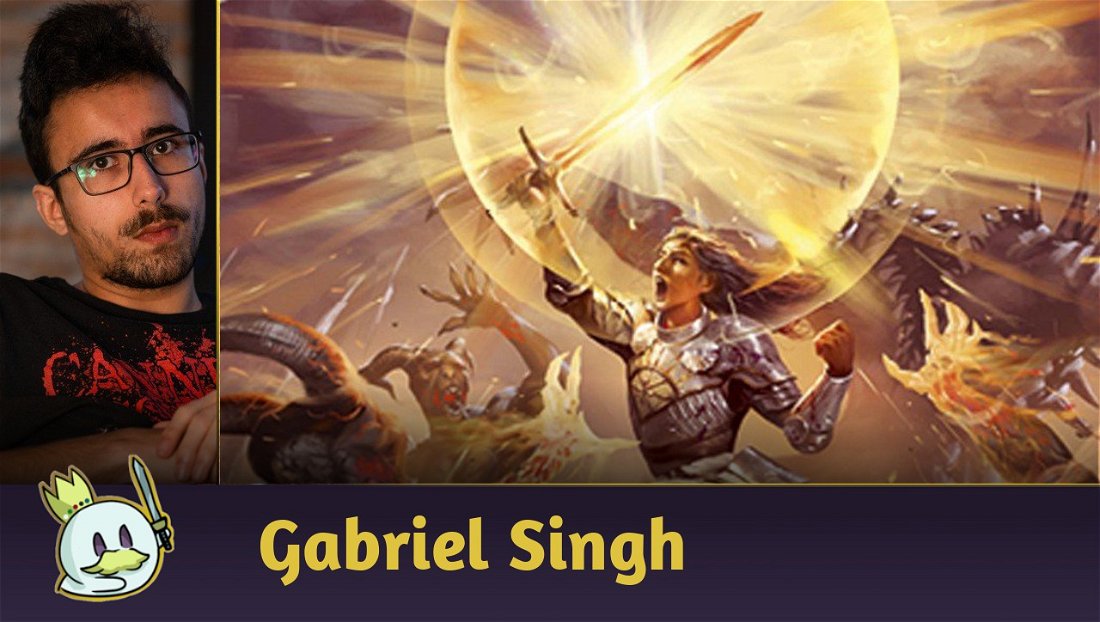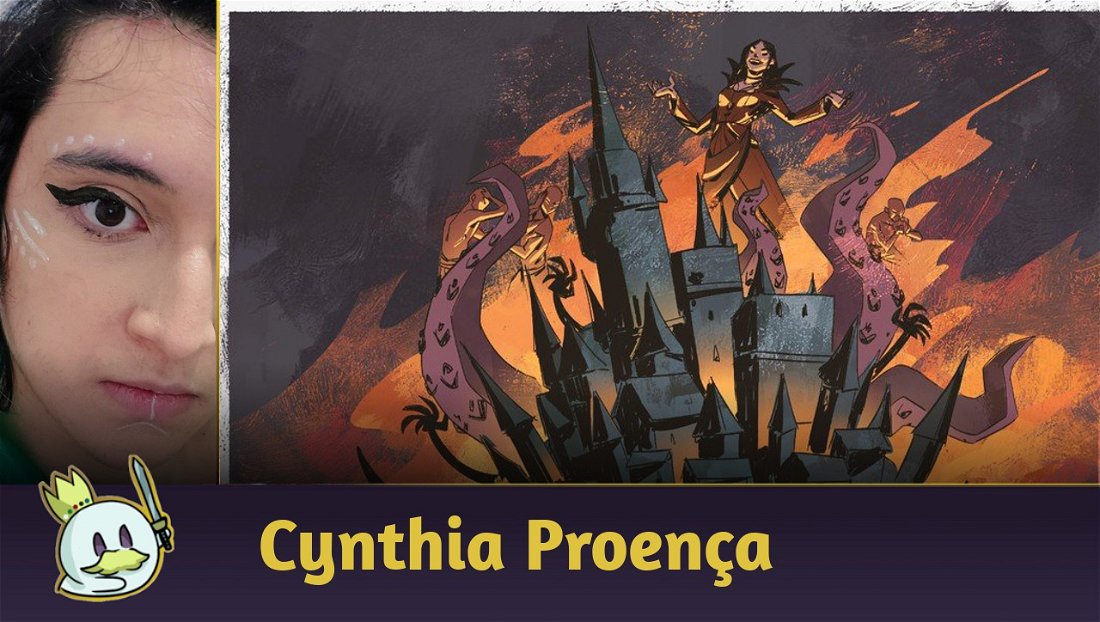Flesh and Blood, a card game created by James White and produced/distributed by Legend Story Studios arrived in Brazil this week, three years after the launch of its first set, Welcome to Rathe. The game has become famous in the United States and Europe and already has an extensive competitive scene, including a world championship taking place on November 6th.
As a personal review, I've been playing TCGs since I was 13, starting with Yu-Gi-Oh! and migrating to Magic: The Gathering at 15. In these eighteen years, I've already witnessed and experienced some of the most famous card games released in recent times, such as Keyforge, Hearthstone and Legends of Runeterra. None of them came close to make me as fascinated as Flesh and Blood did - the game is incredibly well-built and rewards factors such as skill, resource handling, and comprehensive understanding of the game's mechanics, while looking to get around some of the natural flaws of a TCG, such as products availability and banlist.
In this article, I present five of the main factors that delighted me with Flesh and Blood, and why they are great reasons for you to start playing this new worldwide phenomenon.
What is Flesh and Blood?
One of our writers, Gabriel Singh, made a article explaining what it is the game and how to play it, and also made another text explaining the concept behind the game
. I recommend reading both to understand a bit more about this TCG.
In this article, we'll focus on why you should play Flesh and Blood.
1 - It resembles classic RPGs
At the beginning of a match, each player introduces their hero and then chooses the setup for that duel with their equipment, which includes a weapon, helmet, armor, gloves and boots.
Each hero, in addition to its name, also has a class, such as Warrior, Ninja, Wizard, Ranger, Illusionist, Machinist, among others, including some with elemental attacks and abilities, or aimed at a specific theme such as summoning dragons made of ash.

The equipments add a level of customization and preparation similar to what we see in RPG games, especially electronic ones like Final Fantasy, where moments where we need to adapt our equipment to fight a powerful enemy aren't uncommon.
In addition, the class system and the nature that you need to respect this element when building your deck will make you naturally focus on certain types of cards and abilities based on your chosen character's class, as is also the case during tabletop RPGs like Dungeons & Dragons.
So, if you're into RPGs, there's a lot of familiarity in this TCG's themes with games you're probably familiar with.
2 - Every format has its own appeal
Flesh and Blood currently has four official formats: Classic Constructed, Blitz, Commoner and Ultimate Pit Fight. And each of them has its own nature and appeal.

For example, Classic Constructed is the most played format in major competitive events. In it, the player chooses an adult version of a hero and builds a deck of 60 to 80 cards including their equipment and weapons, the matches last a maximum of 50 minutes. Additionally, the deck can contain up to three copies of each card, and the young versions of heroes cannot be played in this format.

Instead, the younger variants, which normally have less health, can be used in the Blitz format, where the deck must have exactly 40 cards, plus up to 11 equipment and weapon slots, with a limit of two copies for each card.
Blitz games are faster, as well as getting more support for in-store games thanks to Blitz Decks, sealed products that come out in each set with two or more assorted decks ready to play straight out of the box, making it a viable option for beginners.

And in case you consider that the prices of Legendary cards are too expensive for your pocket, Flesh and Blood has the Commoner format. It basically follows the same rules as Blitz, but with two differences: each card in your deck needs to be common, and your equipment can include up to two rares.
Finally, there's Ultimate Pit Fight, a multiplayer mode perfect for casual games with your friends. It also follows the same pattern of rules as Blitz, with some rules of its own, such as only being able to attack the player on your left or right.
Along with sealed formats like Draft, the game gives you a significant number of ways to learn and enjoy the experience of participating in an in-person TCG, and the flexibility between them allows the player to start at the bottom, building a Commoner deck, and then gradually invest in Blitz, and then consider playing Classic Constructed if your local scene promotes this format or if you want to play the major events.
In addition, with unique archetypes in each modality, Flesh and Blood makes your competitive scenarios look unique without the need to create an artificial rotation to differentiate one from the other. A list that succeeds in Classic Constructed might be bad at Blitz, and a hero that excels at Commoner might not have the same impact when we put other rarities in between. Thus, each Metagame remains unique and has its own appeal for the player.
3 - It rewards good decisions
It is very common, in many card games, to associate our losses or sub-optimized plays with bad luck and variance. And although this actually happens at times, this is normally a natural defense mechanism most human beings recur to avoid admitting their own mistakes.
In Flesh and Blood, the variance factor is much reduced by its deckbuilding and gameplay: you manage many resources simultaneously between cards in your hand, equipment, weapon and hero-specific abilities, and you need to plan well when you should use each of them to reduce the number of resources your opponent will have on their turn and/or ensure the best damage sequencing on your turn. And yes, this is easier said than done.

One of the key elements of strategy in the game is the pitch: each card has an amount of action points that it generates when you use it to generate resources, and these points must be used to play other cards from your hand and/or activate abilities of your weapon, equipment or hero. Then the card will be placed at the bottom of your deck - that is, you will draw it again at some point if the game gets too long.
So understanding what to pitch to decide what to play, and when you should play it is critically important when you're the active player for the turn. On the other hand, when it's your opponent's turn, it's also essential to understand when you should block with the cards in your hand, as this will mean one less resource on your next turn and, consequently, give you one more turn to your opponent, which will try to sequence other explosive chains against you.

In addition, each piece of equipment has a specific ability, and knowing which ones to use against certain characters and understanding the right timing to resort to them makes a huge difference. Therefore, the game rewards you a lot for making the right decisions, while punishing you for sub-optimized or poorly planned choices, both when building your list and even more when piloting it.
4 - Cards with lower rarities matters
A common flaw in countless TCGs that have passed through the market is the natural conception that the rarer a card is, the more powerful it needs to be, and the more archetypes will need them to compete in events, and their absence in certain lists basically makes the mere possibility of building that archetype impossible.
This is common in pretty much all TCGs, some examples are Fetch Lands in Magic: The Gathering, or some Extra Deck monsters in Yu-Gi-Oh!, or certain Pokémon and Supporters in Pokémon TCG, and so on. In addition, many of these staples may or may not have variants for collectors, or they already appear exclusively in a rarity aimed at opening multiple booster packs.
Flesh and Blood has its rarity pattern, with Common, Rare, Super Rare, Majestic, Legendary, Fabled, and Marvel, and the Super Rares were phased out and moved to Majestic. And some of them, from Legendary onwards, start to have relatively high prices comparable to other TCGs, but the game was built up to this point to make them, in most cases, don't need more than one copy, given that, usually, they are equipments.

There are a few exceptions, with generic cards like Art of War, Command and Conquer and Enlightened Strike, as well as the famous Fyendal's Spring Tunic, but even they won't be universally needed in all strategies, despite being important investments and recommended for your collection.

Of course, paying around $150.00 for a Fyendal's Spring Tunic, possibly one of the most useful staples for Classic Constructed, is an extremely high price for a piece of cardboard.
But then again, you only need one copy of it for whatever deck you're going to play, and if you consider a format like Blitz, the tunic might not even be an automatic inclusion, as you won't get as much out of it in certain matchups due to the fast-paced nature of the games.

Most of the constructed format lists are made up of Common, Rare and some Majestics cards, and by decreasing the mandatory slots of Legendary pieces, or ensuring that the lower rarities really matter when building your deck, Flesh and Blood makes the "enjoy the game" factor tangible to everyone.
Added to the fact that some sets naturally emphasize certain classes or characters and that LLS offers preconstructed products for beginners at a cheap price, this makes the card game accessible and easy to acquire for beginners.

Even the highest rarity Fabled cards in the game have a limiter on the amount you can run on just one copy, and even Eye of Ophidia, played to reduce RNG by filtering the top when you pitch it, isn't a ubiquitous piece on competitive lists.
In short, Flesh and Blood has a philosophy where what the player needs plenty of copies should stick to lower rarities, while higher rarities are geared towards equipments, where you only need one copy of them to play, or in artifacts with limited and non-mandatory slots, as well as items aimed at collectors.
5 - The company's communication is great
The last of the five reasons to play Flesh and Blood is communication: John White and LLS are very clear about what they intend for the game, from the release window to how cards are or aren't banned.
Even the banlist announcements are always accompanied by a detailed explanation, in addition to the Living Legend system, where a hero accumulates points as they win major tournaments and, when they reach a certain mark (1,000 points for Classic Constructed and 500 for Blitz), that character is no longer legal in that format.
Thus, the company guarantees to keep the game fresh and prevents an oppressive strategy from needing unexpected interventions - if something is dominating the competitive landscape too much, it will eventually become a Living Legend and will no longer be available in tournaments or there will be a ban on some key-piece to that strategy to balance things out.
Conclusion
There are many other reasons to start playing Flesh and Blood, but these five present some of the main attractive elements of this TCG, and with three years, a promising competitive landscape and doing things right where other franchises fail, it seems to have what it takes to consecrate itself in the card games market.
If you want further information about the game, you can visit the game's official page, and also look forward to more content about it here at CardsRealm!
Thanks for reading!













— Comments 0
, Reactions 1
Be the first to comment